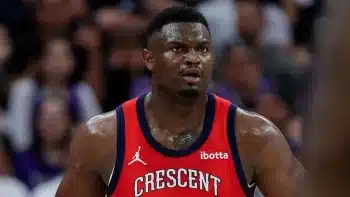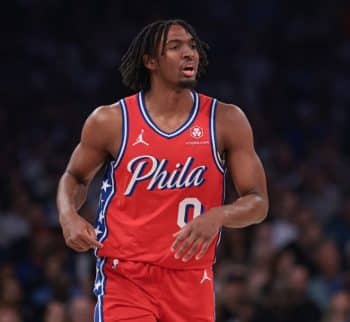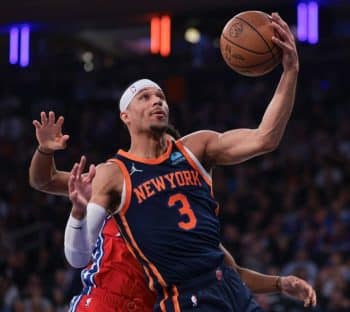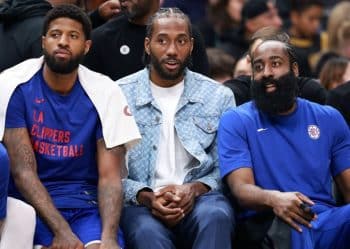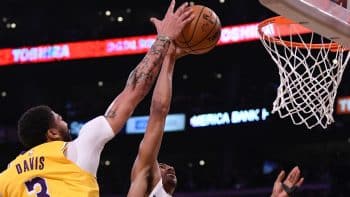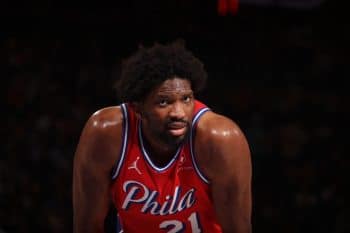NBA
Biggest NBA Stat Surprises At Half Way Point
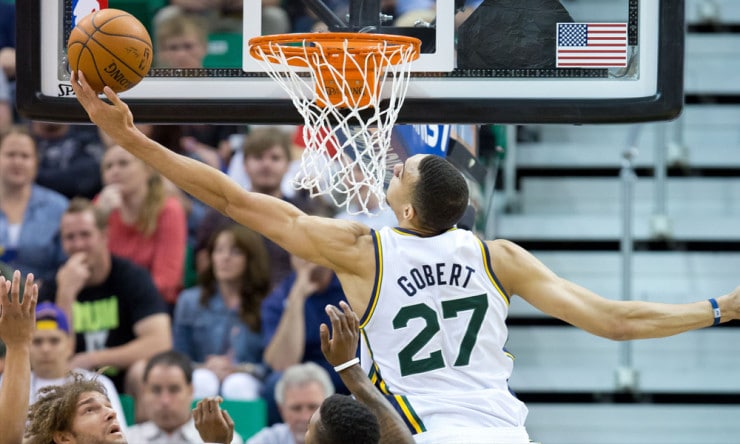
There have been quite a few unexpected twists halfway through the NBA season. As of today, the Oklahoma City Thunder would not make the playoffs, the Los Angeles Clippers and San Antonio Spurs are in the bottom four of the Western Conference playoff race, the New York Knicks are a league-worst 6-36, the Milwaukee Bucks have a similar record to LeBron James’ Cleveland Cavaliers and the Atlanta Hawks are the cream of the crop in the Eastern Conference.
These are some of the surprises in the standings, but there have also been some big surprises on an individual level. For example, we have recently seen breakout performances from young centers like Jusuf Nurkic and Hassan Whiteside, and significant overall improvements from players like Jimmy Butler and Draymond Green. Here we explore some of the most surprising statistics through the first half of the NBA season:
Rudy Gobert’s Defensive Statistics –
Utah Jazz center Rudy Gobert got a lot of attention during the offseason for his performance against the Spanish National team in the FIBA Basketball World Cup. He was active defensively and helped France upset Spain in the quarterfinal round of the tournament.
Building off this performance, Gobert is proving to be a defensive force in just his second NBA season. As of today, Gobert is third in the NBA in total blocks (93) behind only Anthony Davis (108) and DeAndre Jordan (99). But Gobert has managed this while playing just 21.3 minutes per game. In fact, Gobert leads the league in block percentage at 8.4, which is significantly higher than Anthony Davis’ block percentage (6.3).
So Gobert blocks a lot of shots. That’s impressive, but not a total surprise considering his height, length and athleticism. However, consider also that Gobert is ranked ninth in box score +/- at 4.9, per basketball-reference.com. This places Gobert ahead of players like Tim Duncan, DeMarcus Cousins, Marc Gasol, Jimmy Butler and Paul Millsap. Additionally, Gobert is tied for first in defensive +/- (4.3), 18th in PER (21.6), seventh in total rebound percentage (19.4), 15th in win shares per 48 minutes (.185), and is third among all centers in ESPN’s Defensive real-plus minus rating (3.86).
At 22 years old, Gobert is still very raw and has a lot of room to improve, however, based on these statistical measures, he is already making a significant impact on the court for the Jazz.
Kyle Korver’s Shooting Percentages –
On Monday, our own Alex Kennedy broke down Kyle Korver’s historically good shooting so far this season.
As of today, Korver is shooting 51.5 percent from the field, 53.6 percent from beyond-the-arc and 92.2 percent from the free-throw line. He also has a career best 73.9 true shooting percentage, which Kennedy pointed out would be the highest single-season mark in NBA history among players who attempted at least 300 field goals.
In addition, Korver is on pace to have the first qualified 50-50-90 season in league history (that is when a player shoots over 50 percent from the field, 50 percent from the three-point line, and 90 percent from the free-throw line). Most elite shooters would be thrilled to have a 50-40-90 season, which has been achieved by only six players in NBA history (Steve Nash, Larry Bird, Mark Price, Reggie Miller, Dirk Nowitzki and Kevin Durant). Instead, Korver is on pace to join a league of his own.
Some people may argue that Korver is known as a sharpshooter, so these statistics are not much of a surprise. But Korver is 33 years old and was more likely to start regressing this season than have a career year. Instead, Korver is matching his career high three-point shooting percentage, is shooting a career-best percentage from the field and second best free-throw percentage. Korver may have already been known as a sharpshooter, but this season he has taken it to whole other level.
Jimmy Butler’s Offensive Numbers –
Last offseason, Jimmy Butler turned down the Chicago Bulls’ extension offers, opting to try and play his way into a max contract offer next offseason. The move was a gamble on Butler’s part, but apparently he knew something the rest of us didn’t.
Butler’s offensive game has improved significantly this season. He is scoring 20.6 points per game after averaging just 13.1 points per game last season. That is a massive jump that few, if any, predicted considering last season Butler shot just 39.7 percent from the field, 28.3 percent from three-point range and 76.9 percent from the free-throw line.
Butler has improved in other categories as well, such as assists, but the improvement in scoring is the biggest surprise. The Chicago Bulls have taken notice of Butler’s improvement and are reportedly prepared to offer him a max contract after the season. It looks like Butler’s gamble will soon pay off.
K.J. McDaniels’ Shot-Blocking –
Philadelphia 76ers rookie K.J. McDaniels was known as a high-flyer and surprisingly good shot blocker in college. However, most fans and analysts didn’t really expect his shot blocking to carry over to the pro level.
Well, McDaniels has had a fair share of highlight plays, but he has also carried over his unique shot blocking skills. As of today, McDaniels is 15th in total blocks (58), tied for 17th in blocks per game (1.4), and tied for 10th in block percentage (4.7) with Gorgui Dieng, which puts him ahead of players like Andre Drummond, teammate Nerlens Noel, Marc Gasol, Derrick Favors and DeMarcus Cousins.
Remember McDaniels is a 6’6 small forward who is athletic, but not exactly on Gerald Green or Andrew Wiggins’ level athletically. McDaniels’ shot blocking prowess has been well-documented this season, but not many people would guess that he was blocking shots at a higher rate than some of the more accomplished centers in the league.
Hassan Whiteside’s Player Efficiency Rating –
Hassan Whiteside has been a revelation in his 17 games with the Miami HEAT this season. His box score numbers aren’t great—7.4 points, 5.8 rebounds and two blocks per game— but that is because he is only averaging 15.5 minutes per game this season.
According to ESPN (Insider), Whiteside is rated sixth in the league in PER at 26.01. This places Whiteside ahead of players like LeBron James, DeMarcus Cousins, Chris Paul, Dwyane Wade, Blake Griffin, Damian Lillard, Marc Gasol and the list goes on.
Whiteside may eventually come back down to earth considering the small sample size, but it is nice to see a player that appeared to be a draft bust improve his game and get a second chance in the league.
Kobe Bryant’s Shooting Percentages –
Kobe Bryant, age 36, entered this season after recovering from of a torn Achilles tendon and lateral tibial plateau fracture in his left knee. Considering this, expectations for Bryant needed to be tempered entering this season. However, Bryant is a workaholic, relentless competitor and an all-time great player, so there was a minority belief that he could overcome these obstacles and have a season close to his typical high standards.
Bryant has had flashes of his old self, but more often he has been uncharacteristically ineffective, especially shooting the ball. This season, Bryant is shooting a career low in overall field goal percentage (37.2), two-point field goal percentage (39.8), true shooting percentage (47.7), and fourth worst three-point percentage (29.6).
Some of Bryant’s worst shooting performances include: 1-of-14 against the Spurs, 6-of-22 against the Mavericks, 3-of-15 against the Thunder, 8-of-30 against the Kings, 2-of-12 against the Clippers, and 3-of-19 against the HEAT.
Again, Bryant is in his 19th NBA season, has a ton of mileage on his body, is coming off two major injuries, played too many minutes per game early in the season and has gotten to the point where he needs take games off due to exhaustion. But couple Bryant’s shooting woes with his second ranked usage percentage (34.9) and it becomes clear why Bryant’s performance this season hasn’t helped the Lakers compete at a high level.*
We knew entering this season that Bryant wouldn’t be the same superstar he has been throughout his incredible career, however, it is still surprising to see how poorly he has been shooting the ball.
Damian Lillard’s Improved Shooting at the Rim –
Yesterday, Kirk Goldsberry of Grantland detailed how Damian Lillard has improved his shooting around the rim, which was perceived as a weakness last season.
Last season, Lillard shot 48.5 percent within five feet of the basket and 46.7 percent within ten feet. This season, he is shooting 59.6 percent within five feet of the basket and 55.9 percent within ten feet. In addition, last season Lillard shot 40.2 percent on 7.7 drives to the rim per game, which generated 5.7 points per game, per SportVU. This season, Lillard is shooting 49.7 percent on 9.3 drives per game, which is generating 6.4 points per game. This improvement has Lillard ranked 10th in the league in points per game on drives to the rim.
To illustrate the improvement in this aspect of Lillard’s game, here are Lillard’s shooting charts from last season and this season:
2013-2014
2014-15
Shooting charts courtesy of www.statmuse.com/nba/
As you can see, with his improved ability to finish at the rim, Lillard is taking and making more shots at the rim this season.
We all knew Lillard could shoot the ball from deep. Now Lillard has added the ability to finish through contact at the rim, which makes him even more dangerous than he was last season.
Blake Griffin’s Rebounding –
In the 2010-11 season, Blake Griffin exploded onto the NBA scene with highlight dunks and huge box score numbers. While Griffin has added new dimensions to his game each season, his rebounding rate has oddly dropped off.
In his rookie season, Griffin averaged 12.1 rebounds per game whereas this season, Griffin is averaging 7.6 rebounds per game. Griffin was playing more minutes per game as a rookie than he is this season, but that doesn’t account for how far his rebounding rate has fallen.
As a rookie, Griffin had a total rebounding percentage of 18.6, whereas this season, he has a 12.4 total rebounding percentage. Part of the explanation for this is that Los Angeles Clippers head coach Doc Rivers prioritizes getting back on defense rather than fighting for offensive rebounds. However, Griffin’s defensive rebounding rate has declined each season as well, which is not related to his coaches’ defensive scheme.
Part of the explanation may be that Griffin is allowing his teammate DeAndre Jordan to clean up the boards more often so that he can leak out in transition to be a playmaker with his unique dribbling and passing abilities (as evidenced by his career-best 24.9 assist percentage this season). But it is still surprising that his overall rebounding hasn’t stabilized at this point in his career, resulting in a career-low 7.6 rebounds per game this season.
Rasual Butler’s Three-Point Shooting –
If you had to guess which three players lead the league in three-point percentage this season, you may guess players like Stephen Curry, Klay Thompson, Damian Lillard, Kevin Durant or J.J. Redick. If you guessed any of those players, you would be wrong.
At age 35, Rasual Butler is shooting a career-best 46.6 percent from the three-point line on 3.4 attempts per game. Butler has been a pretty good three-point shooter throughout his career (36.6 percent career average), but entering this season, no one would have guessed that he would rank third in three-point percentage behind only Kyle Korver (53.6) and Courtney Lee (47).
Last season, Butler shot well from beyond-the-arc (41.9 percent) in 50 games for the Indiana Pacers, but that was in significantly less playing time and with less three-point attempts per game. Credit goes to Butler for working on his game and improving so dramatically in his twelfth NBA season.
Matt Barnes’ Shooting Percentages –
Critics of the Los Angeles Clippers usually point to their small forward depth as an Achilles heel for the team. It’s not hard to understand why considering that the Clippers are currently relying on Barnes, Dahntay Jones, Hedo Turkoglu and Jamal Crawford in small-ball lineups to man the position.
At age 34, Barnes is still a scrappy and effective defensive wing-player. But one of his perceived weaknesses is his perimeter shooting. Barnes is a career 33.8 percent three-point shooter and had a miserable preseason*, causing concern that he would be a liability for the Clippers this season.
Regardless of his slow start to the season, Barnes is currently shooting 48 percent from the field, a career-best 59.8 percent on two-point field goals, a career-best 39.5 percent from beyond-the-arc, and has a career-best 61.8 true shooting percentage (which is the eighth best true shooting percentage in the league).
Barnes may not be as effective on defense as he used to be, but, at least for now, the criticism of his shooting should be put to rest.
These are just some of the many surprising statistics through the first half of the season. Let us know in the comments section which stats you think are some of the most interesting or surprising ones so far this season.
Unless noted otherwise, all stats are courtesy of Basketball-Reference.com or NBA.com/stats.


